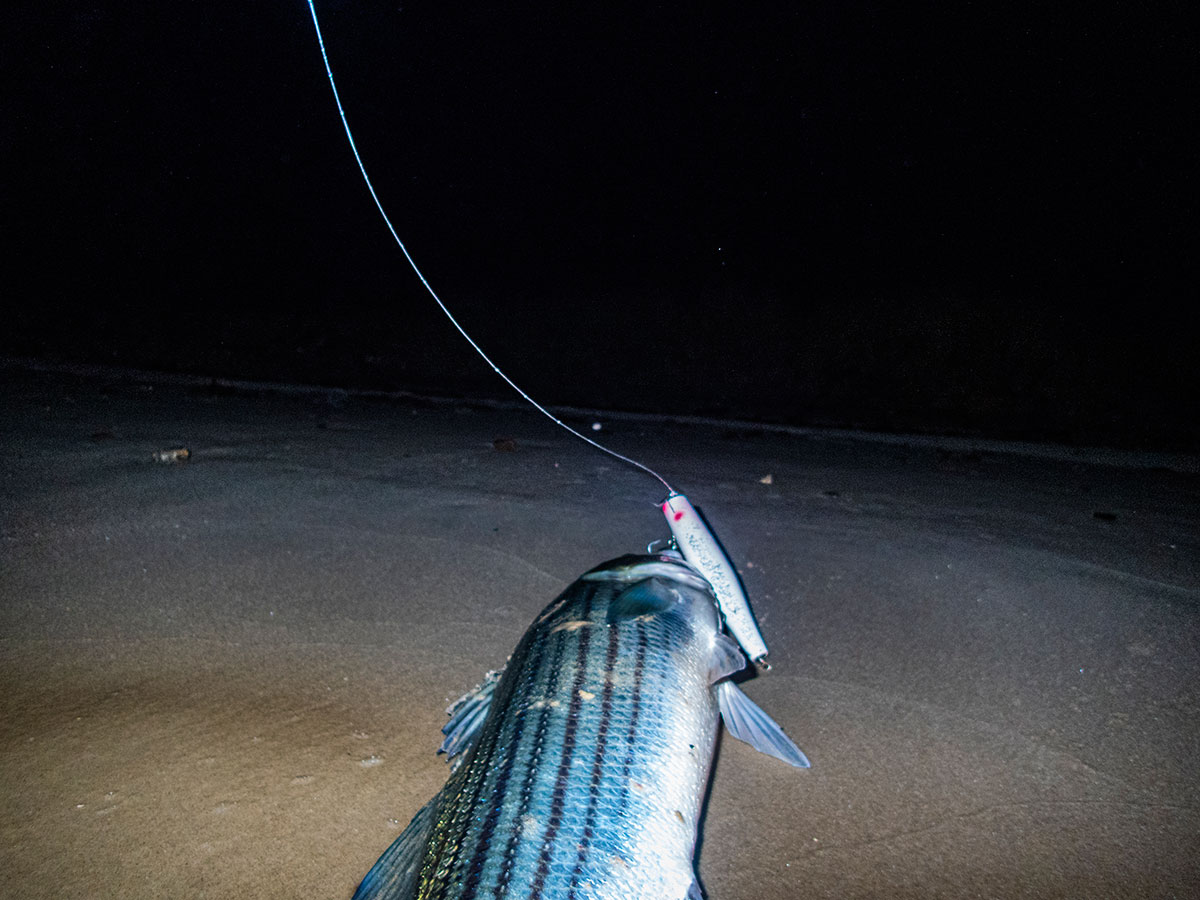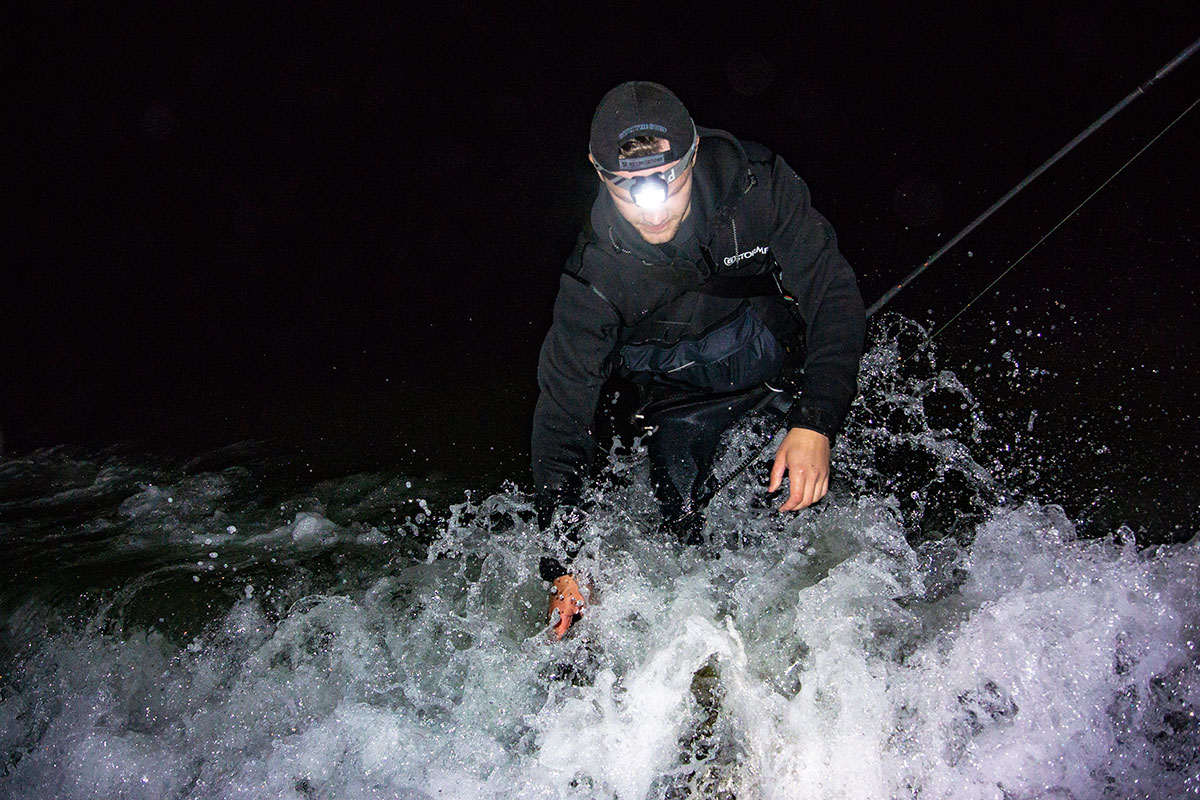
Fish as close as you can to either side of the storm, whether a hurricane or a Nor’easter.
Log Entry September 9, 2018. 7:20pm to 11:45pm. Air Temperature 62, Water Temperature 72. NE winds 20-25mph, gusting to 35. New Moon, 0% illuminated. Barometer: Dropping. Outgoing tide.
It’s been crazy hot, but this is only the second major northeast wind of the season—so I had to fish! I started in the boulder fields because it looked fine—not too big. However, the waves were big enough, and powerful enough in combination with the tide that I was being pushed off my rock and right back to shore—and I still had two hours until high tide! It freaked me out so I bailed and went elsewhere. I decided to go check out the estuary because it has been looking good for a week or more—absolutely filled with peanuts, and small fish have been there constantly popping bait on the surface. I started off fishing with Red Fins and Bombers and had a few hits, but no hook-ups; small fish I think. I put on a Super Strike darter, tossed it out at the edge of the rip line…Bingo! I had over a dozen fish in the next hour, a couple that were large schoolies but the majority of the fish were 14 to 18 pounds. I decided to see what else was out there, so at 10 pm on my watch, I cast out a big Savage Gear glide bait. I took one turn of the handle and felt a very faint bump; the ocean was really building, and I had a decent bow in my line. I did a half hook-set, and had a fish on. It didn’t seem like much at first. But then holy $&#*, it took off and took a run that must have been 40 yards long—my longest run in a few years! At the end I felt a slight ping and she was gone! I thought it broke me off, so I was reeling it back pretty fast, and then suddenly I had a fish again. I hadn’t been broken off after all, and now I had another fish on. That fish was only maybe 15 pounds. I had a handful of small fish over the next hour to about 12 pounds on both the Savage Gear Freestyler and a Super Strike darter. Since I was over two-dozen fish on the night, and they seemed to be getting smaller, I called it quits and headed home. It’s on!
Early fall is one of my absolute favorite times to fish, whether it is salt or freshwater. Kids are back in school, vacations are over, and the water and shore becomes a lot less crowded—and the fishing gets better. Yet, many fisherman tend to hold off much too late when pursuing stripers in the surf, waiting for a big push of bass or much cooler weather and water. Since large pushes of big bass are getting more and more rare—especially for us surf fisherman—I have found that the first few weather events are some of the most critical moments of the entire season for catching a trophy fish, perhaps second only to the early spring run. Year after year, I catch one of my top five largest fish of the season during this period, and usually three of five. Not to mention this is, without question, the time of year I really crank up the numbers of moderately-sized fish I catch, with nights every season of 20, 30, or even 50 fish in a single tide. The time is now; don’t wait until the leaves start changing. You can catch up on sleep in the winter!
But what do I mean by a weather event? It’s relatively simple and doesn’t always mean a Nor’easter. I do generally look for winds with some form of “E” (east) in them, a strong low barometric pressure, and rain is almost always a good thing. Those parameters generally mean one of the three things: the aforementioned Nor’easter, an active tropical storm, or a dying hurricane. This time of year, I prefer Nor’easters as they can drop the water temperature enough to really get the fish going wild. But it isn’t just water temperature that is important, and you don’t absolutely need it. Let me set up a scenario.
It’s early September. It’s been high-80s to low 90s for a few weeks without relief. Surface water temperatures are 75 at the coast, and you haven’t caught anything of size for a while. Sure, you see a Nor’easter is about to roll up along the Northeast Coast, but it’s still going to be almost 70 degrees during the day, and the water temperature is probably not going to drop much, if at all. So you are not inclined to fish and instead opt to stay home saving your vacation time for October.
This is, in my opinion, a huge mistake. It is based on an assumption that is both very common, but also wrong. While I do fully acknowledge—and love—that rapid drops in water temperature this time of year can be phenomenal in triggering a bite, there is more to these systems than that. The more important thing, especially early on, is that fish can sense the drop in barometric pressure. This is at least in part supported by real data-drive science. They are evolved to react to the seasonal triggers (e.g. sun angle, moon phase, bait presence, water temperature, etc.) in association with these drops in pressure, which “tells” them that it’s time to put on as much weight as possible. As a result, they start becoming more aggressive, competitive, and less wary—all benefiting us as anglers, especially those that are plug and fly anglers. As such, they will very frequently go on a feeding binge even when the water temperatures are still “wrong,” say over 70 degrees.
I have experienced this time and time again. In the example above from my log, the ocean temperature last year was certainly over 70 degrees, and likely even warmer in the back water that was rushing out into the ocean. Yet, I had a large body of moderately-sized fish feeding aggressively. This goes against some conventional wisdom, yet here is the proof! However I know—based on experience—that if I had fished that spot at that same exact time of year without the Nor’easter, it would have only resulted in perhaps a handful of 20-inch fish, and perhaps even a skunking.
However, it doesn’t just have to be Nor’easters as I eluded to previously. Hurricanes and tropical low-pressure systems are also great and probably underrated. They stir up some pretty serious surf, and this time of year fish are starting to key up their metabolisms for the migration and the long winter. A big surf can be just enough to get your resident fish to feed after weeks of lethargy and small feeding windows. As such, I do not wait necessarily for a swirling low pressure system coming across the country and a 20-plus-degree drop in temperature. Instead, I keep an eye on the south, and if I can get a solid build in surf with any wind with an “E” in it, I’m definitely dropping my plans and fishing that night. And as always, this is especially true around the moons.
The other critical component that helps in timing is when you see your local tidal rivers, estuaries, and ponds filled up with young-of-the-year bait. I noted this in my log, as I have shared above. If the bait is particularly early or late during a given season, you may want to adjust your expectation of the first few weather events. I’m referring primarily to peanut bunker, silversides, and mullet for the locations I fish, and if you see high concentrations of these key players anywhere in your area, you should be preparing for that first weather event. I have particularly done well with mullet in the past few seasons.
So what defines early fall? Depending on where you live, it may actually already have slightly passed you, but you’re still right in it. Many underestimate just how early the migration may begin, and these weather events can play a substantial role. I fish all over the Striper Coast. I have had phenomenal nights in late August and very early September in Massachusetts, kicked-off by a low-pressure weather event. I have concluded that this is either the residents being triggered to begin their fall-feast in preparation for winter, or perhaps it is newly migrated fish starting south from Maine; I’ve never been able to determine which. However, when I fish southern New England and Montauk, I only get really excited about low-pressure systems when I see them in middle or late September. That about covers the full expanse of my fishing haunts, and you can fill in the dates for your area by moving my dates either further into August or October.

During this time of year I do think “match the hatch” at times, but for the most part you don’t have to worry very much about that. When these events come, and it’s pouring rain and the surf is pounding, it’s all about just getting your offering in front of the fish, which can be challenging at times! This is the time of year for bucktails, needlefish, and bottle-plugs, which all allow you to punch through the wind and to the fish. Up-size your gear, and check it for any weaknesses, because the fish are fired-up and in combination with the heavy surf they will test your knots and any frayed main lines or leaders. It’s also not a bad time to fish the surf during the day. Since fish are aggressive, they have the cover of a roiling surf, and bait fish are thick, they are often more willing to venture in tight to shore during the day. I do not fish during daylight very much during the entirety of the season, but when I do it primarily falls during this time period. The blitzes can be extremely fun to partake in, and are even fun to just watch.
But what if you’re not really in to a giant surf, or unable to partake in the onslaught due to scheduling issues? Fish as close as you can to either side of the storm, whether hurricane or Nor’easter. I know many great fisherman love the onset of the storm, and I can’t really argue with that. The fish can sense it coming, and it sets them off, since they “know” that they may not be able to feed for a few days. That and they momentarily have a substantial predatory advantage with the large waves and strong currents. However, I have had essentially just as good success fishing immediately after a storm. The key is you don’t want to wait until the water is completely clear; indeed, if you have you’ve missed it. It’s a fine line that might take a little experimentation, but I like the water to still be a bit turbid (stained) and with just enough weed to foul me every few casts, but not every cast. I think this can be the best time to catch the largest fish as they come in to clean up after the more aggressive smaller ones have finished.
So keep an eye on the weather and don’t wait until October; and be safe in those big storms!


